Part One Academic Writing Essentials
Unit 2 The Writing Process
Learning Objectives
- To understand what the writing process is and why it is important
- To learn all the steps in the writing process by studying an assignment from beginning to completion
- To practice the steps in the writing process through exercises
I. Warm-Up

Discuss in groups:
- Have you ever cooked or baked anything? How do you enjoy cooking or baking?
- When you see the above image (two hands kneading dough[1]), what comes to your mind?
- What is essential[2] in baking the perfect bread?
- Why is following steps so important?
- Should writing also follow proper[3] steps?
- What steps do you usually follow when you have a writing assignment?
- What do you think the writing process is?
II. Importance of the Writing Process
As you learned in Unit 1, academic writing should be well organized, focused, and accurate. How do you start?
Imagine baking a loaf of bread. You need to get the ingredients ready, mix them one at a time in the right order to make dough, knead it, let it rise, put it in a container, and bake it for a length of time. Miss or reverse[4] one step, and you may not be able to enjoy the fresh and crusty[5] bread as anticipated. Of course, the bread machine may make the work less laborious[6] for you, but the general process from flour to bread remains the same.
It is the same with writing. It follows a step-by-step order called the writing process. Using the right steps will ensure[7] a good piece of writing that you are proud of.
III. Stages and Steps in the Writing Process
There are three major stages in the writing process. Each major stage includes a few smaller steps.
The Writing Process
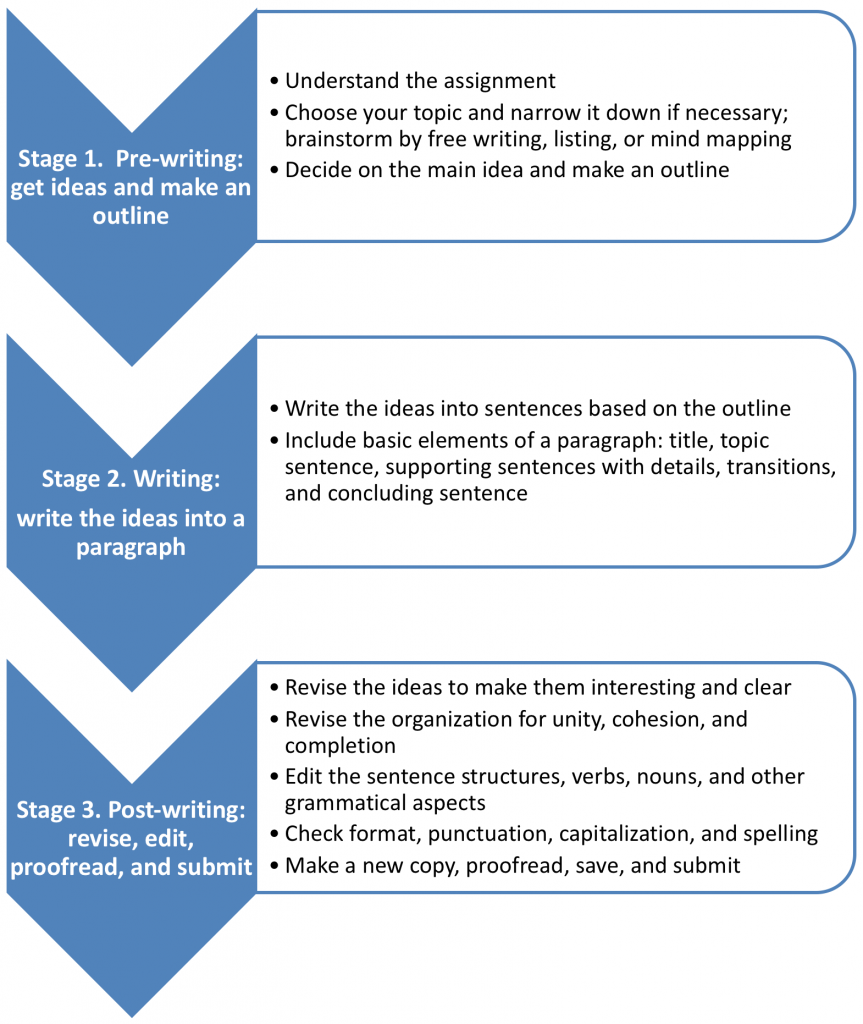
Here is an example assignment to show you how every step works. The process is shown in the boxes below.
A Paragraph Writing Assignment
Purpose: This assignment is to show your understanding of planning and writing a paragraph. Use the writing process to help you.
Topic: What has been your most interesting experience in learning English? Explain three reasons why you think so.
Paragraph: Your paragraph should have a title, 3 supporting ideas with details, and a concluding sentence. Use some transitions to connect the supporting sentences.
Format: Type your paragraph, double spaced, font size 12, with 1-inch margins on four sides of the page. Type your name, class, and date on the upper right-hand corner of the page. The first line of your paragraph should be indented. Save your paragraph in a Word file.
Self Checklist: When you finish writing, use the Self Checklist below. Put a checkmark beside each item if you think you did a good job in that area. Otherwise, improve your paragraph until you can check off the item. Save your work again.
Submission: Submit your paragraph on the Blackboard. Go to your Blackboard course site and follow the instructions there to submit your work. Due by 11:59 pm on Monday, January 30.
Self Checklist
| Questions | Paragraph Revising and Editing Self Checklist | √ |
|---|---|---|
| 1 | Is my paragraph clear to understand? | |
| 2 | Is my paragraph interesting to read? | |
| 3 | Did I include a topic sentence with a clear topic and a controlling idea? | |
| 4 | Did I include 3 supporting ideas with details and connect them with transitions? | |
| 5 | Did I include a concluding sentence? | |
| 6 | Did I try my best to use correct sentence structure, verbs, and other grammar aspects? | |
| 7 | Did I try my best to have correct spelling, punctuation, and capitalization? | |
| 8 | Did I follow the proper paragraph format? |
The Self Checklist will include more specific items as you learn more about writing and editing in the course.
Follow the three stages below to see how this assignment is completed step by step.
IV. Stage 1 Pre-writing: Get Ideas and Make an Outline

1. Understand the assignment.
Each assignment may come with different instructions. Understanding the requirements is crucial[8] in making sure that you start out right. Here is a list of questions you ask yourself to check your understanding of the assignment:
Example: Understand the assignment
| Questions | Answers to show your understanding |
|---|---|
| Purpose? | To show understanding of planning and writing a paragraph |
| How? | Use the writing process |
| Who reads? | My professor and probably some of my classmates |
| Final product? | A paragraph with a title, 3 supporting sentences with details, a concluding sentences, transitions |
| Format? | indent, double space, size 12, 1-inch on 4 sides, name/semester/date |
| Due? | by 11:59 pm, Monday, Jan. 30 |
| Where? | Course Blackboard, follow instructions there. |
2. Choose your topic and narrow it down if necessary; brainstorm by free writing, listing, or mind mapping.
While choosing your topic and narrowing it down,
√ Do:
Write from your heart; consider your own interests and/or knowledge.
Reflect your unique thoughts or experiences.
Ask yourself:
-
- Am I interested in this topic? How much do I know about it?
- Do I have an interesting experience or perspective that most of my classmates might not have?
- Would my readers get to know the topic or me better through my writing?
X Do not:
-
- Pick a seemingly[9] “easy” topic that you do not know much about or do not have a personal, meaningful experience with.
- Google search and choose your topic based on how much information you can find on the web.
For the disadvantages of relying too much on the Internet information, please refer to “Ten Most Common Misconceptions about Writing” in Unit 1 Introduction to Academic Writing. (Open Unit 1 here.)
Brainstorming means that you write down your ideas as quickly as you can for about two to ten minutes, like a storm sweeping through your mind! Do not worry about accuracy in grammar, spelling, or punctuation. Do not be overly concerned whether an idea is good or not. Rather, keep the flow of your thoughts going. You may be surprised to discover many new, hidden ideas.
Brainstorming comes in different ways: free writing, making a list, mind mapping, and some others. They may look different, but your thinking process is the same. Here are the three common brainstorming examples to show you how to get ideas for the above writing assignment on your English learning experience.
Brainstorming example 1: free writing
This is my first writing assignment in class. I want to write about my interesting English study. English, English everyday, important, tired. What aspect? Pronunciation? reading? writing? grammar? listening? Language Lab? my grades? I don’t know… well, maybe something about writing. Right now I’m trying not to translate from my native language. This is stressful, but keep trying. What about writing? yes! no translation! My teacher just taught us NSNT, interesting, I’ll try, maybe this topic? different way but I hope it’ll help me. I tried two times already, tried not to stop writing, holding my pen tight, keep writing. Possible not to translate if I keep doing it . The teacher isn’t checking my mistakes, so I’m more relaxed this way. Also fun because focus on my ideas and learn to express in total English. My teacher said, this skill will help me succeed in ESL and college classes. I want to learn. I know it’s important. teacher said translation no good, agree, my language and English very different, think in English, habit, try every day, confidence.
English learning experience: Reading, writing, listening, speaking, language lab, international students club
a. reading: interesting stories, new words, dictionary, too many words, hard, useful, in context, guessing first??
b. writing: academic writing, paragraphs, topic sentence, punctuation, NSNT, new, interesting, hard, feel strange, how not to translate? worry my grade
c. listening: news, recordings, hard, too fast, when driving, language lab, good materials, open, helpful staff, lots of resources, what to choose
d. speaking: international students club, games, prizes, snacks!! new friends, some native speaks, every week, fun, nervous
Brainstorming example 3: creating a mind map
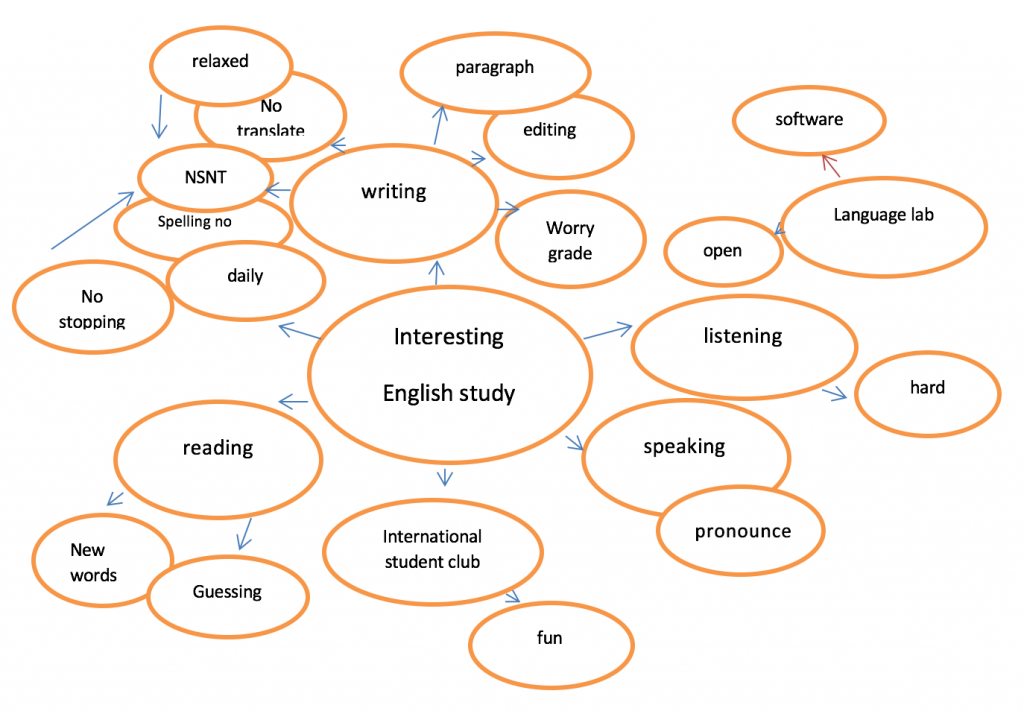
You take a second look at your brainstorming and consider which area to focus on (main idea) and what information to keep or throw out. At this point, you decide to write about NSNT and the reasons why you like it.

For information about the NSNT approach, please refer to Appendix A NSNT Approach. (Open Appendix A here.)
Then you organize your ideas into a simple plan called an outline. It may take five to ten minutes to make an outline.
- Write the topic sentence in a complete sentence on top of the page.
- Write your supporting ideas and their details in words and phrases, or even some symbols like # for number and $ for money. Do not write complete sentences and do not write a draft of the paragraph. When you write your ideas in words and phrases in the outline, you can spot the problem more easily if an idea does not support the topic sentence.
- When you write your paragraph later, you may have an additional idea. Do not include it in your paragraph directly. Put it in your outline to make sure it helps explain the main idea. You may ask yourself:
-
- Does this idea support my topic sentence?
- Which part of the outline should I put it in?
- Is there already a similar idea in the outline?
An outline example:
| Parts of a paragraph | Paragraph outline |
|---|---|
| Title | The Reasons Why I like NSNT
(It is common to write the title after you finish the outline or the paragraph draft.) |
| Topic sentence
|
The Non-Stop-Non-Translation (NSNT) approach is one of my most interesting experiences in learning English.
(Write a complete sentence) |
| Background info if necessary | what is NSNT in 1-2 sentences |
| Support 1 | translation habit, different languages, others don’t understand well, a good habit of thinking in English |
| Details 1 | no subject in Spanish sentence, wrong in English |
| Support 2 | think faster and more naturally in English |
| Details 2 | better flow, less time in communication, not two languages in my mind |
| Support 3 | not too hard, more relaxed, want to write more, motivation |
| Details 3 | try every day, with music, not graded, from 5 to 15 minutes now, topics like current events, memories |
| Concluding sentence | summarize 3 ideas and give opinion |
V. Stage 2 Writing: Write Ideas into a Paragraph

This is the stage where you create the first copy of a complete paragraph based on the outline. This copy is called a draft. It usually takes a longer time to write than the pre-writing activities, but once you have completed the previous steps, you have made this stage of writing much easier to accomplish.
Example: Paragraph draft
The Non-Stop-Non-Translation approach has been one of my most interesting experiences in learning English. My teacher introduce it in the beginning of the semester. Students writes on a topic nonstop for at least 5 minute, and they should not translate their ideas from their native languages to English. First, the strategy helps me learn to express my self correctly with english. i been in the U.S. for only one year, and I always translate my ideas from Spanish to English. However; people often do not understand me, or they say I am wrong. i am learning to think faster and more natural with the help in NSNT. My teacher instruct us not to let the tip of our pen to leave the surface of the paper, so we have to keep writing, even writing days of the week and months of the year until our brains forces out some ideas in English. Though, I felt very uncomfortable in the beginning now after two months of training, I starting to feel that my ideas flow more easy in English. The discussions we have in reading classes also help me think in English because my classmates cannot wait for me to translate from Spanish. Lastly, the daily practice is not as stressful as I thought so I enjoy it. I turn on my favorite music, and write from 5 minutes to 10 minutes daily. I feel I can write more and more. Because my teacher do not grade my work based on accuracy. Can let my thoughts flow freely on paper without worrying about my grade.
You have tried to write a good paragraph though it still has mistakes. Do not worry! No one can write perfectly on the first try. The instructions in Stage 3 below will guide you step by step in making your paragraph better.
VI. Stage 3 Post-Writing: Revise, Edit, Proofread, and Submit the Draft
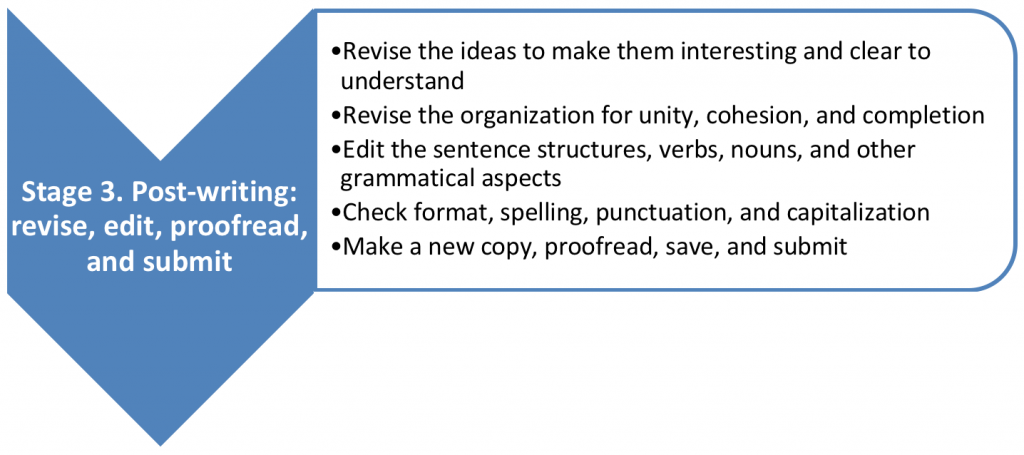
1. Revise the ideas and organization – comments in (parentheses) and marked in pink
(No title)
The Non-Stop-Non-Translation approach is one of my most interesting experiences in learning english. My teacher introduce it in the beginning of the semester. Students writes on a topic nonstop for at least 5 minute, and they should not translate their ideas from their native languages to english. First, the strategy helps me learn to express my self correctly with english. i been in the U.S. for only one year, and I always translate from Spanish to english (when?). However; people often do not understand me, or they say I am wrong. (example?) (transition?) i am learning to think faster and more natural with the help in NSNT. My teacher instruct us not to let the tip of our pen leave the surface of the paper, so we have to keep writing, even writing days of the week and months of the year until our brains forces out some ideas in English. Though, I felt very uncomfortable in the beginning now after two months of training, I starting to feel that my ideas flow more easy in English. The discussions we have in reading classes also help me think in English because my classmates cannot wait for me to translate from Spanish. (irrelevant and should be deleted) Lastly, the daily practice is not as stressful as I thought so I enjoy it. I turn on my favorite music and write from 5 minutes to 10 minutes daily. (examples of what I write about) I feel I can write more and more. Because my teacher do not grade my work based on accuracy. I can let my thoughts flow freely on paper without worrying about my grade. (no concluding sentence)
Make a new copy to show improvement in ideas and organization.
The reasons why I like NSNT
The Non-Stop-Non-Translation approach is one of my most interesting experiences in learning english. My teacher introduce it in the beginning of the semester. Students writes on a topic nonstop for at least 5 minute, and they should not translate their ideas from their native languages to english. First, the strategy helps me learn to express my self correctly with english. i been in the U.S. for only one year, and I always translate my ideas from my native language Spanish to english when communicate. However; people often do not understand me, or they say I am wrong. For example, it is correct to write “Es un dia bonito” in Spanish. When I translate it into english. My sentence becomes “Is a day beautiful.” Second, I am learning to think faster and more natural with the help in NSNT. My teacher instruct us not to let the tip of our pen leave the surface of the paper, so we have to keep writing, even writing days of the week and months of the year until our brains forces out some ideas in English. Though, I felt very uncomfortable in the beginning now after two months of training, I starting to feel that my ideas flow more easy in English. Lastly, the daily practice is not as stressful as I thought so I enjoy it. I turn on my favorite music and write from 5 minutes to 10 minutes daily, and sometimes even longer. I have written about childhood memories, current events, and school activities. I feel more comfortable and confident in expressing my thoughts. I no longer need to fill time with “Monday, Tuesday…” as in the beginning. Besides, my teacher do not grade my work based on accuracy. Can let my thoughts flow on paper without worrying about my grade. The NSNT is one of the best approach in helping me think and use English. I will definitely keep practicing this strategy.
2. Edit grammar and sentence structure
3. Check format, spelling, punctuation, capitalization
It is common to combine these two steps, but it is better to do Step 2 before Step 3. The mistakes in grammar, sentence structure, punctuation, capitalization, spelling, and format are highlighted in grey and corrections are highlighted in purple below.
Name? Jane Doe
Class? Writing III
Date? January 25, 2022
The reasons Reasons why I like Like NSNT
The Non-Stop-Non-Translation approach is one of my most interesting experiences in learning english English. My teacher introduce introduced it in the beginning of the semester. Students writes write on a topic nonstop for at least 5 minute minutes, and they should not translate their ideas from their native languages to English. First, the strategy helps me learn to express my self myself correctly with english English. i been I have been in the U.S. for only one year, and I always translate my ideas from my native language spanish to english. When communicate. … and I always translate my ideas from y native language Spanish to English when I communicate. However; , people often do not understand me, or they say I am wrong. For example, it is correct to write “Es un dia bonito” in Spanish. When I translate it into english. My sentence becomes “Is a day beautiful.” When I translate it into English, my sentence becomes “Is a day beautiful.” Second, i I am learning to think faster and more natural naturally with the help in NSNT. My teacher instruct instructs us not to let the tip of our pen leave the surface of the paper, so we have to keep writing, even writing days of the week and months of the year until our brains forces force out some ideas in English. Though, I felt very uncomfortable in the beginning Though I felt very uncomfortable in the beginning, now after two months of training, I starting have started to feel that my ideas flow more easy easily in English. Lastly, the daily practice is not as stressfull stressful as I thought so I enjoy it. … I thought, so I enjoy it. I turn on my favorite music and write from 5 minutes to 10 minutes daily. About childhood memories, current events, and school activities. … 10 minutes daily about childhood memories, ... I feel I can write more and more. Because my teacher do not grade my work based on accuracy. Can let my thoughts flow on paper without worrying about my grade. I feel I can write more and more because my teacher does not grade my work based on accuracy. The NSNT is one of the best approach approaches in helping me think and use English. I will definitely keep practicing this strategy.
Fix the mistakes and make a new copy:
Jane Doe
Writing III
January 25, 2022
The Reasons Why I Like NSNT
The Non-Stop-Non-Translation approach is one of my most interesting experiences in learning English. My teacher introduced it in the beginning of the semester. Students should write on a topic nonstop for at least 5 minutes, and they should not translate their ideas from their native languages to English. First, the strategy helps me learn to express myself correctly with English. I have been in the U.S. for only one year, and I always translate from Spanish to English when I communicate. However, people often do not understand me, or they say I am wrong. For example, it is correct to write “Es un dia bonito” in Spanish. When I translate it into English, my sentence becomes “Is a day beautiful.” Second, I am learning to think faster and more naturally with the help in NSNT. My teacher instructs us not to let the tip of our pen leave the surface of the paper, so we have to keep writing, even writing days of the week and months of the year until our brains force out some ideas in English. Though I felt very uncomfortable in the beginning, now after two months of training, I am starting to feel that my ideas flow more easily in English. Lastly, the daily practice is not as stressful as I thought, so I enjoy it and write from 5 minutes to 10 minutes daily. I have written about childhood memories, current events, and school activities. I feel I can write more and more. Because my teacher does not grade my work based on accuracy, I can let my thoughts flow freely on paper without worrying about my grade. The NSNT is one of the best approaches in helping me think and use English. I will definitely keep practicing this strategy.
4. Use the Self Checklist to make sure that you have tried your best to revise and edit the paragraph. Put a checkmark in the box on the right if you have done your best in that area.
Self Checklist
| Questions | Paragraph Revising and Editing Self Checklist | √ |
|---|---|---|
| 1 | Is my paragraph clear to understand? | √ |
| 2 | Is my paragraph interesting to read? | √ |
| 3 | Did I include a topic sentence with a clear topic and a controlling idea? | √ |
| 4 | Did I include 3 supporting ideas with details and connect them with transitions? | √ |
| 5 | Did I include a concluding sentence? | √ |
| 6 | Did I try my best to use correct sentence structure, verbs, and other grammar aspects? | √ |
| 7 | Did I try my best to have correct spelling, punctuation, and capitalization? | √ |
| 8 | Did I follow the proper paragraph format? | √ |
The Self Checklist will include more specific items as you learn more about writing and editing in the course.
Proofread means that you read the paragraph from beginning to end at least one more time to catch the errors you missed and to make sure that your writing is as good as it can be.
Now you can save your work and submit it. Job well done!

Going through the steps takes time, but you can be sure that your paragraph will be the best you can write it. Some of you may feel that following the process is too much trouble and that it is a waste of time, but remember that you may need longer time redoing the assignment later if you do not properly follow the writing process. Think of this as establishing[10] a good habit of thinking and writing. Over time, you may be able to combine some of the steps and save some time. However, you will be writing much longer, much more complicated compositions in your future classes, and the habit of following the writing process will definitely help you succeed.
VII. Unit Review Practice
Exercise 1. Discuss the following questions about the writing process.
- What is the writing process? Why is it important?
- What are the three stages in the process? What are the steps in each stage?
- Have you tried the writing process or a similar process before? Share your experiences.
Exercise 2. Narrowing down a broad subject will help you focus better on the main idea of your paragraph. Practice narrowing down the topics. The first two are examples. You see that the same broad topic can be narrowed down to two different focuses depending on your experiences and preferences. Compare and discuss your answers with your partner.
Examples:
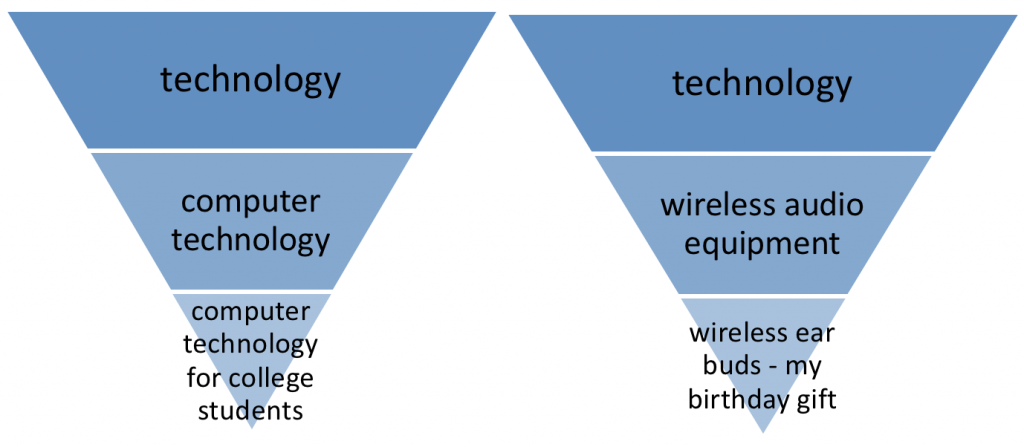
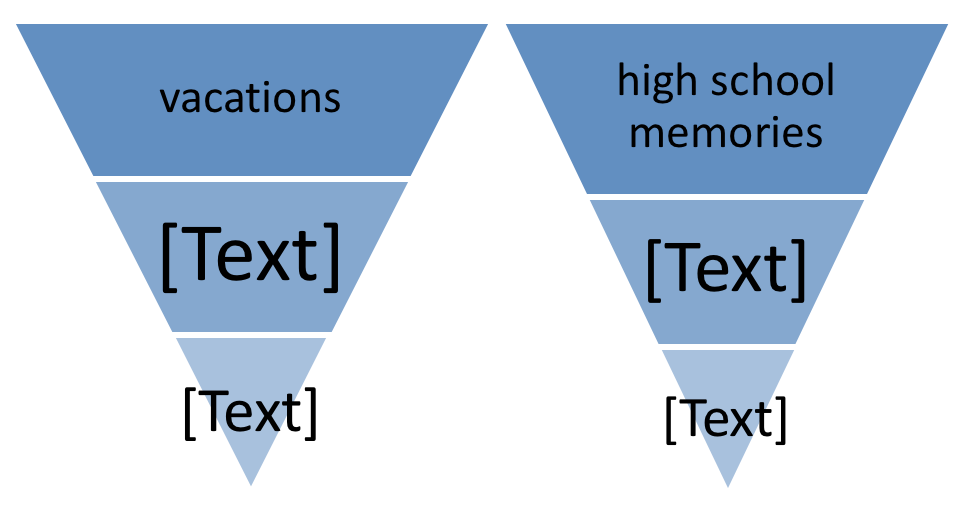
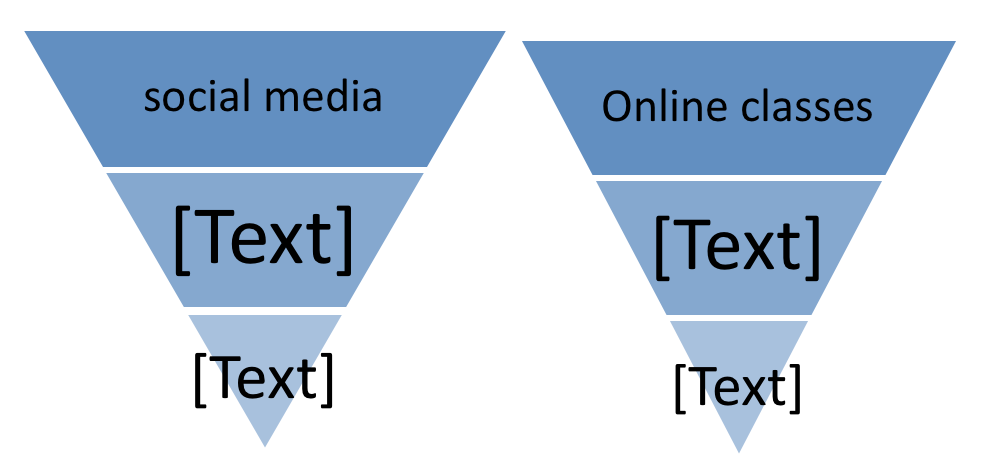
Exercise 3. Look at the following ideas from brainstorming. Add some of your own to the list. Then put the ideas into the categories. The categories will be used as supporting ideas when you write the paragraph. If an idea does not fit the main idea, cross it out. An example is provided in each category.
Main idea: Jerry’s Burgers is my favorite lunch place.
fast service, nice decorations, fresh ingredients, clean washrooms, beautiful paintings on walls, Asian and Middle Eastern flavors, meeting room, noisy, not many salad choices, expensive, smiling owner, no place for kids to play, free soda, no parking, tasty soup bowls, kids’ menu, low fat menu, vegetarian choices, background music too loud, gluten-free options, polite wait staff, no delivery…
Example:
| Food | Services | Facilities |
|---|---|---|
| fresh ingredients
|
fast service
|
meeting room
|
Exercise 4. Use three of the following topics to try free writing, listing, mind mapping. Narrow down the topic if necessary. Then write an outline for each topic. Lastly, choose one of the three outlines to write a paragraph.
- driving in the U.S.
- my first class in the U.S. college
- the neighborhood where I grew up
- the person I admire the most
- a childhood memory
- a disappointing holiday
- advantages or disadvantages of cell phones
- characteristics of a good shopping mall
NSNT Practice

Go to The NSNT Free Writing Approach and Additional Weekly Prompts for Writing in Appendix A. (Open Appendix A here.) Choose two topics to practice the steps in the writing process. You may do the NSNT free writing approach while brainstorming. Remember not to translate from your native language and not to stop writing once you start.
Vocabulary Review

The words here have appeared in this unit. The best way to learn them is to guess the meaning of each word from the context. Then hover your computer mouse over the number beside each word to check its meaning and part of speech. These words are also listed in the footnote area at the end of each unit.
Here, you can use the flashcards below to review these words.
Summary
- There are three major stages in the writing process:
- pre-writing: get ideas and make an outline
- understand the assignment
- choose topic, narrow down if needed
- brainstorm – free writing, make a list, create a mind map
- writing: write a draft of the paragraph
- write a paragraph based on the outline
- include basic elements of a paragraph
- post-writing: revise and edit, proofread, and submit
- revise ideas to make them clear and interesting
- revise organization for unity, cohesion, and completion
- edit sentence structure and grammatical aspects
- check format, punctuation, capitalization, and spelling
- make a new copy, proofread, save, submit
- The stages and steps ensure the good quality of your paragraph.
Media Attributions
- kneading dough © Photo by Salomé Watel on Unsplash
- The Writing Process © Lin Cui is licensed under a CC0 (Creative Commons Zero) license
- Stage 1 Writing Process © Lin Cui is licensed under a CC0 (Creative Commons Zero) license
- a mind map on English learning experience © Lin Cui is licensed under a CC BY (Attribution) license
- a pen writing in a notebook © Photo by Aaron Burden on Unsplash
- Stage 2 Writing Process © Lin Cui is licensed under a CC0 (Creative Commons Zero) license
- Stage 3 Writing Process © Lin Cui is licensed under a CC0 (Creative Commons Zero) license
- a man dancing on a rock with a sunset on horizon © Photo by Aziz Acharki on Unsplash
- narrowing down ideas © Lin Cui is licensed under a CC0 (Creative Commons Zero) license
- narrowing down ideas © Lin Cui is licensed under a CC0 (Creative Commons Zero) license
- narrowing down ideas exercise © Lin Cui is licensed under a CC0 (Creative Commons Zero) license
- a page in a dictionary © Pixabay
- dough: noun, a mix of flour, water, and other ingredients to make into bread, cake, etc. ↵
- essential: adjective, extremely important, cannot live without ↵
- proper: adjective, suitable, appropriate, right ↵
- reverse: verb, follow the opposite order ↵
- crusty: adjective, crisp, describing the outer layer of freshly-baked bread ↵
- laborious: adjective, with lots of work ↵
- ensure: verb, make sure, to be certain ↵
- crucial: adjective, very important ↵
- seemingly: adverb, in appearance but may not be true ↵
- establish: verb, build, set up ↵

